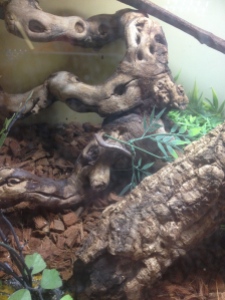
The caption to this photo, which appeared in the Florida Times-Union: the brown anole has overrun Florida. Sometimes called Cuban anoles, they have become the most abundant vertebrate on Florida land.
The Florida Times-Union from Jacksonville published an article today on Florida invasives that arrived from Cuba. Pasted below is what they have to say about our favorite, the brown or festive anole, Anolis sagrei. You’ll have to go to the paper’s website to read about the Cuban brown (or festive?) snail and the Cuban treefrog:
This little lizard has an aggressive streak.
Related: Warming Cuba relations spurs invasive species debate
Swiftly, quietly, the brown anole has overrun Florida. Sometimes called the Cuban anoles, they have become the most abundant vertebrate on Florida land, with recorded populations exceeding 10,000 per hectare.
But really, this is a tale of two lizards. When the brown anole first started to colonize the Florida mainland in the 1940s, it came across another lizard, small and slender just like itself.
The bright green Carolina anole had been the only anole lizard native to Florida, and it had prospered across the Southeast United States. But, suddenly, it found itself in a turf battle with the invading brown anole.
They were both color-changing lizards, between 5 to 8 inches in length, competing for the same territory and the same food. But the brown anole had the upper hand. Back in Cuba, it shared an island with over 60 other anole lizards. It had to bulk up to face its rivals.
“In some sense, it’s better evolved, better adapted to competing with other anoles, so when it gets to Florida, it’s more aggressive and a little bit heavier,” said Yoel Stuart, a post-doctoral researcher in integrative biology at the University of Texas at Austin.
He told the Times-Union that he has heard many native-born Floridians lament the disappearance of the green Carolina anole in recent years, as the brown ones took over.
But all is not lost for the Carolina anole.
Stuart led a study of Carolina and Cuban anoles, and he found that the little green lizards were evolving rapidly to face down the invading force.
For their study, Stuart and his colleagues “battled weather and salt water and malfunctioning motors and leaky boats,” to reach isolated islands on Florida’s Atlantic coast.
They arrived armed with what Stuart describes as “a little extendable fishing pole with a little lasso at the end of it.” And when they spotted a lizard, they tried to slip the lasso around its neck, to collect measurements.
The Cuban anoles had, as expected, settled all but five of the 30 islands they visited. But how quickly the Carolina anoles were reacting surprised the researchers. They had fled to the canopy where, in the course of just 15 years, they had sprouted vastly bigger feet with stickier scales.
“If human height were evolving as fast as these lizards’ toes, the height of an average American man would increase from about 5-foot-9 inches today to about 6-foot-4 inches within 20 generations,” Stuart said in a news release. That would make the average American the same size as a NBA shooting guard.
That rapid evolution will likely allow the Carolina anole to coexist with the brown anole.
“It’s not going to go anywhere,” Stuart said. “It’s just going to be a little less abundant, a little bit higher up in the trees.”
But Stuart sees the brown anole’s rampant success as a warning, especially as other exotic lizards try to make Florida their home. He points out that South Florida is under siege by tegu and monitor lizards.
“People should realize if they buy a pet and can’t keep it, they shouldn’t just release it,” he said. “You never know which one is going to take off and start breeding in the wild.”














